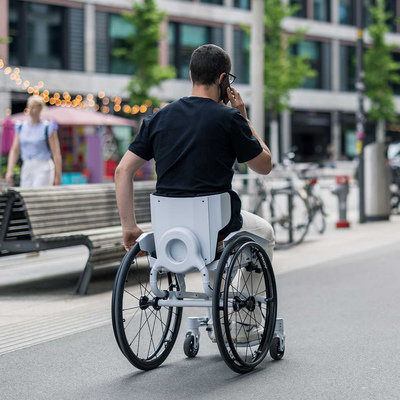Research assistants at ETH Zurich’s Laboratory for Movement Biomechanics have identified a problem common to users of manual wheelchairs. Reto Togni and Stefan Villiger learned that wheelchair users have to constantly correct course, putting undue strain on their shoulders and occasionally causing injury. When rolling across a surface that’s tilted to one side—as sidewalks are, in order to shed rain—the user must push harder on the down side. Also, when turning, the user must essentially apply the brakes on one side while pushing with the other side, effectively working against themselves.
Togni and Villiger came up with a clever solution. Their modified wheelchair design can be put in “steering mode,” whereby the front wheels are locked into a straight position. The backrest is connected to the rear wheels, and when the user leans, the wheelchair turns:
To test their design out, the duo had 29 participants each navigate an obstacle course six times, using both a conventional wheelchair and the prototype. The comparison showed a clear difference:
“It was already clear in the first round that the test participants needed much less energy to steer with the backrest,” says Togni. Co-developer Villiger took part himself and confirms: “When travelling with the prototype along the straight incline, I didn’t have to correct the steering with my hand once. And it was also much easier to move forward round the bend. With the conventional wheelchair I was constantly braking and propelling at the same time.” This is also shown in the evaluations (see diagram).


Although the test participants required less energy to move forward with backrest-steered wheelchairs, they travelled faster than when in conventional wheelchairs. This astonished even the researchers: “You normally need more energy the faster you travel,” says Togni.
…there are also further health benefits: the gentle body movements needed for steering are also likely to stimulate the blood flow and can provide relief against backache and indigestion. Moreover, the weight shift relieves the bottom and could help to prevent pressure marks.
Another advantage is that you can navigate with one hand and have the second hand free to transport things from one place to another – be it an umbrella, mobile phone or a coffee.

The only downside to the design is, it makes it more difficult to do 180s in place and to navigate within tight environments. For that reason, Togni and Villiger have designed their prototype to be able to switch back to the normal steering configuration.
Togni points out the importance of doing user research, which is what enabled he and Villiger to come up with the design improvement. “The wheelchair has [been viewed as something for caregivers to use] as a device for transporting sick and disabled people and has until now been viewed too little from the user’s perspective.”

The duo have secured a patent, but have run into an obstacle preventing them from going into mass production: The onerous rules of the Swiss healthcare system, which demands high adjustability for different body sizes. The duo are confronting the challenges and hope to have their design on the market by 2027.
Here’s Togni explaining and demonstrating the design:
Enter a caption (optional)

